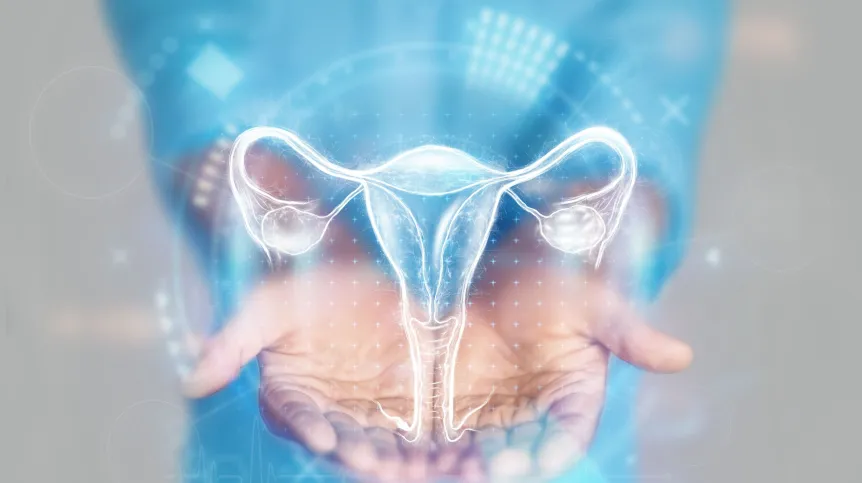
Artificial intelligence can improve ovarian cancer diagnostics. Studies show that it is better at recognizing ovarian cancer cases than both experts and other doctors. Its diagnostic accuracy is 86 percent, Professor Artur Czekierdowski from the Medical University of Lublin told PAP.
In January this year, the scientific journal Nature Medicine published the paper 'International multicenter validation of AI-driven ultrasound detection of ovarian cancer', co-authored by Professor Artur Czekierdowski from the Department of Gynecological Oncology and Gynecology at the University Clinical Hospital No. 1 of the Medical University of Lublin.
The artificial intelligence models were designed at Karolinska Institutet in Stockholm. The researchers used a model of neural networks based on deep learning to analyse ultrasound images of ovarian tumours. After appropriate training, these methods were tested on over 17,000 ultrasound images obtained from 3.6 thousand patients with ovarian tumours. They were shown to 33 experts from eight countries, and to less experienced doctors in this field, who were asked to determine whether the tumour was malignant or benign. Then, their diagnoses were compared with the diagnostic capabilities of artificial intelligence models.
'It turned out that artificial intelligence was better at recognizing ovarian cancer cases than both experts and other doctors. Its diagnostic accuracy was 86 percent, while experts were at 82 percent and non-experts were at 77 percent', Czekierdowski says.
He points out that artificial intelligence is most widely used in the analysis of imaging examinations (e.g. ultrasound, MRI, CT), because the human eye is not able to extract all the information that is in a given ultrasound image. According to the professor, artificial intelligence methods can discover features of an image that are characteristic of malignant tumours that are invisible even to an expert. 'AI tools in their simplest form have been increasingly used in healthcare for at least 25 years. These are generally computer programs, but the whole problem is to train them so that their analyses and results are reliable', the researcher explains.
According to the professor, artificial intelligence can improve ovarian cancer diagnostics. 'Thanks to the data obtained using AI technology, in the future we will be able to select a more appropriate type of treatment for the patient, predict survival or the risk of disease recurrence', he believes.
The expert adds that 8 percent of tumours are so difficult to identify that even the best experts are unable to differentiate the type of tumour before surgery. He says that unnecessary surgeries in the case of tumours that - as it later turns out - have a very low risk of malignancy are also a problem.
Professor Artur Czekierdowski emphasises that current AI technology can support clinical decisions, but it does not force a specific medical procedure. 'It can already be used as an auxiliary method, which will be of great importance in the context of the small number of experts in this field of gynaecological oncology', the expert says.
Asked about the future of AI in medicine, he emphasises that we are no longer able to escape it. 'It is already everywhere, but we often do not realize that various AI systems suggest a diagnosis to us. The whole problem is the ability to properly use AI-based programs', Czekierdowski explains.
Since 2001, the University Clinical Hospital No. 1 in Lublin has had an ovarian pathology diagnostic clinic. Approximately 150-250 patients are consulted there annually. The professor reports that significantly more ovarian cancers are detected in women in the Lublin province at an early stage of advancement. In recent years, the youngest patient of the gynaecology clinic with ovarian cancer was 14 years old, and the oldest - 94 years old.
Patrycja Ziober-Malinowska, PhD, M.D., from the Department of Gynecological Oncology and Gynecology at the University Clinical Hospital No. 1 of the Medical University of Lublin emphasises that ovarian cancer is a potentially fatal disease, especially when diagnosed at an advanced stage, when the chances of 5-year survival are around 20-25 percent. 'Ovarian cancer is called a silent killer, because in the early stages of the disease it does not cause any symptoms at all. That is why imaging methods are constantly sought that will be able to detect and estimate the risk of cancerous changes even in small, 1-2 cm changes in the ovary. Prognostic models created by artificial intelligence enable doctors to estimate such risk at an early stage for small changes that may be missed and treated as benign by inexperienced doctors', the specialist explains.
Thanks to this, it is possible to operate on even the smallest neoplastic lesions, which consequently affects the possibility of preserving fertility in young patients who want to have children in the future.
'Artificial intelligence serves as an aid, but will never completely replace a doctor. Medicine can surprise us in various clinical situations. That is why AI technology is an auxiliary tool, its purpose is to streamline work, improve the results of cancer diagnostics, increase the detection of ovarian cancer in early stages. All this, in turn, translates into the results of treatment. The earlier the cancer is detected, the greater the chance of recovery', Ziober-Malinowska emphasises. (PAP)
Science in Poland
gab/ bar/ amac/













